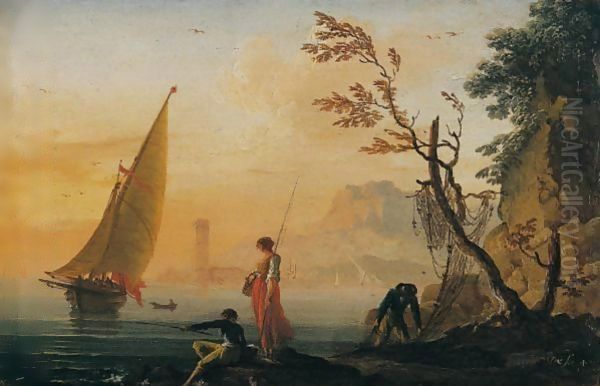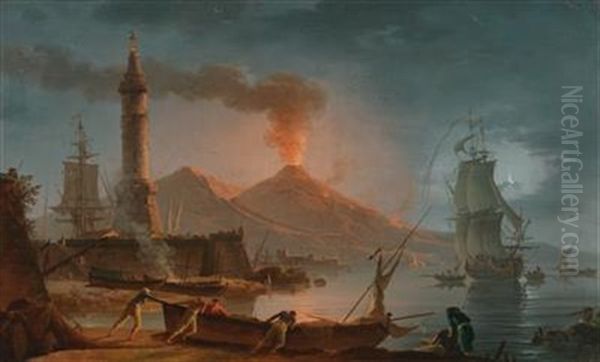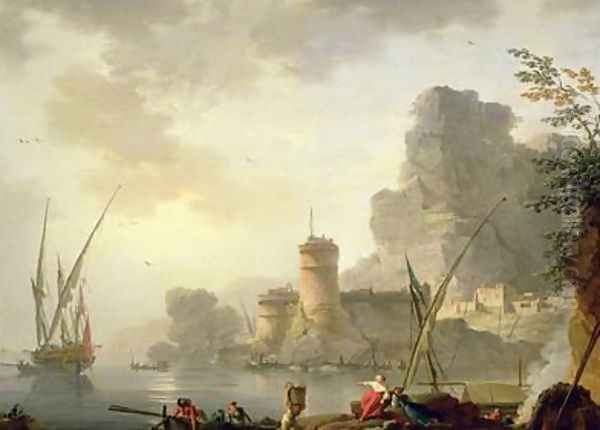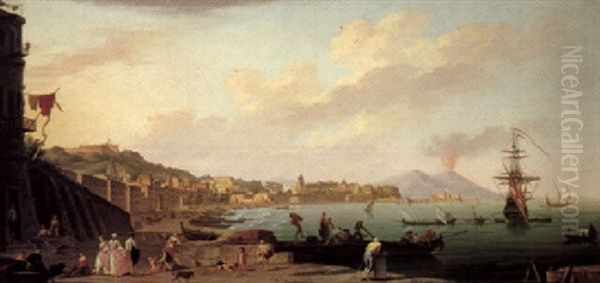Charles François Lacroix, often known as Lacroix de Marseille, stands as a significant figure in eighteenth-century French art. Born in Marseille around 1700 and active until his death in Berlin in 1782, Lacroix carved a niche for himself as a painter of evocative landscapes and seascapes, deeply imbued with the spirit and light of Italy. His work forms a fascinating bridge between the established traditions of landscape painting and the burgeoning sensibilities that would later blossom into Romanticism. Though details of his personal life remain somewhat scarce, his artistic journey, particularly his close association with the celebrated painter Claude-Joseph Vernet, and his long sojourns in Italy, shaped a distinctive style that captivated collectors of his time.
Lacroix specialized in capturing the atmospheric effects of the Mediterranean coast, the tranquil beauty of its harbours at dawn or sunset, and the picturesque allure of ancient ruins nestled within serene landscapes. His paintings are often characterized by a delicate handling of light, a harmonious composition, and a poetic, sometimes idyllic, mood. While deeply influenced by his master, Vernet, Lacroix developed his own nuances, favouring a slightly softer, more decorative approach that resonated with the prevailing Rococo tastes while still honouring the classical landscape tradition.
The Shadow of Vernet: Early Career and Roman Apprenticeship
The formative years of Charles François Lacroix's career are inextricably linked with Claude-Joseph Vernet (1714-1789), the preeminent French landscape and marine painter of the era. While Lacroix was born earlier, it appears his significant artistic development occurred somewhat later, particularly after encountering Vernet. It is widely accepted that Lacroix was a pupil, and likely an assistant, to Vernet during the latter's highly successful period in Rome. Vernet had established himself in the city by 1734, gaining fame for his convincing depictions of Italian landscapes, seascapes, storms, and tranquil harbours, works that were highly sought after by Grand Tourists and European aristocracy.

Lacroix is believed to have arrived in Rome around 1750, immersing himself in the vibrant artistic milieu of the city. Working alongside Vernet provided him with invaluable training. He would have learned Vernet's methods for constructing landscapes, rendering the effects of light and water, and populating scenes with small, lively figures that added scale and narrative interest. Some art historians suggest that Lacroix may have even collaborated directly with Vernet on certain canvases during the early 1750s, absorbing his master's techniques firsthand. The influence is undeniable; Lacroix's early works, in particular, show a strong affinity with Vernet's style, adopting similar compositional structures and thematic concerns.
This period in Rome was crucial. The city itself, with its ancient monuments, the surrounding Campagna, and the nearby coastline, offered endless inspiration. Lacroix, like Vernet, drew upon the legacy of earlier masters who had found inspiration in the Italian landscape, most notably the seventeenth-century giants Claude Lorrain (1600-1682) and Nicolas Poussin (1594-1665), whose idealized visions of nature and antiquity had set the standard for classical landscape painting. Lacroix learned to combine observed reality with an idealized, harmonious vision, a hallmark of the Italianate landscape tradition.
Roman Residency and Artistic Development
Lacroix established himself firmly in Rome, becoming a registered resident ('abitante') in 1754. He remained in the city even after Vernet was recalled to France by King Louis XV in 1753 to paint the famous series 'Ports of France'. This indicates Lacroix had achieved a degree of independence and recognition in his own right. His Roman period, extending possibly until the early 1760s, saw him solidify his reputation as a painter of charming Italianate scenes.
During these years, Lacroix continued to explore the themes popularized by Vernet but began to subtly differentiate his style. He painted numerous views of the Roman Campagna, coastal scenes near Rome (like Ostia or Anzio), and imaginary landscapes incorporating recognizable ancient ruins, such as temples, aqueducts, and triumphal arches. The Arch of Titus, for example, appears in some of his compositions, often integrated into a broader port scene. He excelled at depicting specific times of day, mastering the soft glow of sunrise and the warm, golden light of sunset over the Mediterranean.
His works from this period often feature fishermen, travellers, and peasants, small figures that animate the landscape and provide a sense of everyday life amidst the grandeur of nature or the remnants of antiquity. These figures, while reminiscent of Vernet's, sometimes possess a slightly more delicate, almost Rococo, grace. The artistic environment in Rome included other landscape painters and view-painters (vedutisti), such as Giovanni Paolo Panini (1691-1765), known for his detailed depictions of Roman ruins and festivals, offering a different, more topographically focused approach compared to Lacroix's atmospheric interpretations.
The Neapolitan Experience: Vesuvius and the Bay

Around 1757, Lacroix's focus seems to have shifted southwards towards Naples, where he spent a significant period, possibly up to a decade, until about 1767. The Bay of Naples, with its dramatic coastline, picturesque islands like Capri and Ischia, and the imposing presence of Mount Vesuvius, offered a different kind of inspiration compared to the Roman Campagna. This region had its own tradition of landscape painting, touched by the more dramatic sensibilities of artists like Salvator Rosa (1615-1673) in the previous century.
Lacroix embraced the unique scenery of the Neapolitan region. He painted views of the bay, coastal grottoes, and local fishing activities. Crucially, he depicted Mount Vesuvius multiple times. One notable work, reportedly dated 1761, captures the volcano, perhaps in a state of activity or imminent eruption, showcasing his ability to render not just serene beauty but also the sublime power of nature. This interest in dramatic natural phenomena aligns with developing pre-Romantic sensibilities across Europe.
His Neapolitan works retain the characteristic clarity of light and elegant composition found in his Roman paintings, but the subject matter introduces a specific regional flavour. The vibrant life of the Neapolitan coast, the unique volcanic landscape, and the brilliant southern light provided fresh material for his brush. His time in Naples further cemented his reputation as a specialist in Italian scenes, catering to the seemingly insatiable demand from foreign visitors and collectors for souvenirs of their Grand Tour.
Signature Style: Light, Atmosphere, and Idyllic Visions
Charles François Lacroix's mature style is a distinctive blend of influences and personal sensibilities. While the foundation laid by Vernet is always apparent, Lacroix cultivated his own artistic personality. His primary achievement lies in his mastery of light and atmosphere. He particularly excelled at capturing the transitional moments of dawn and dusk, suffusing his canvases with warm, gentle light – golden, pink, or silvery – that creates a specific mood, often one of tranquility and peace.
His seascapes frequently depict calm waters, with gentle waves lapping at the shore or reflecting the sky. Harbours are often shown bustling with quiet activity: fishermen tending their nets, ships at anchor, figures strolling along quays. Even when depicting potentially dramatic subjects like shipwrecks, as seen in some works attributed to him, the treatment often retains a certain picturesque elegance, perhaps less terrifying than similar scenes by Vernet or later Romantics like Philip James de Loutherbourg (1740-1812).

Lacroix demonstrated a preference for idyllic and pastoral landscapes over strictly topographical views. While he incorporated recognizable landmarks, his main goal seemed to be the creation of a harmonious and pleasing composition, often evoking a sense of nostalgia or gentle melancholy. His landscapes feature rolling hills, classical ruins often picturesquely overgrown, tranquil rivers or lakes, and graceful trees. The inclusion of small figures adds narrative interest and scale but rarely dominates the scene; the landscape itself remains the primary subject.
His colour palette is typically fresh and appealing, employing clear blues, greens, earthy tones, and the warm hues associated with sunrise and sunset. The application of paint is generally smooth and refined, contributing to the overall elegance of his work. This refinement, the emphasis on grace, and the often decorative quality of his compositions connect his style to the broader aesthetics of the Rococo period, exemplified in France by masters like François Boucher (1703-1770) and Jean-Honoré Fragonard (1732-1806), although Lacroix worked within the more conservative genre of landscape.
Representative Works and Thematic Range
While a definitive catalogue raisonné remains a challenge, several works exemplify Lacroix's style and thematic range. Pairs of paintings, known as pendants, were common, often contrasting different times of day (morning and evening) or different conditions (calm and storm).
Mediterranean Harbour Scene at Sunrise / Sunset: Many of Lacroix's most characteristic works fall into this category. These paintings showcase his skill in rendering atmospheric light, calm waters reflecting the sky, detailed depictions of ships, and lively figures engaged in port activities. They epitomize the idyllic Mediterranean vision popularised by Vernet and continued by Lacroix.
_Coastal Sunset_: A specific example mentioned in sources highlights a Mediterranean sunset with fishing boats and fishermen, emphasizing the warm light and serene mood typical of his best work.
_Fishermen Casting Nets near a Grotto_: This subject combines natural coastal features (grottoes) with human activity (fishing) and often includes background elements like towers or ruins, blending the natural and the man-made in a picturesque composition.
_Shipwreck_: While perhaps less common than his tranquil scenes, Lacroix did paint shipwrecks. These works allowed him to explore the more dramatic aspects of nature, contrasting the power of the sea with human vulnerability, a theme also frequently explored by Vernet.

_View of a Southern Port with the Arch of Titus_ (dated 1780): This later work demonstrates his continued interest in integrating classical architecture within bustling port scenes. The specific mention of the Arch of Titus anchors the scene in Italy, likely Rome or an imagined Roman-inspired setting. Its late date (just two years before his death) shows his adherence to this style throughout his career.
_Vesuvius Erupting_ (or similar titles, c. 1761): His depictions of the Neapolitan volcano stand out for their specific location and potential for drama, capturing a key subject of interest for Grand Tourists visiting Naples.
These examples illustrate Lacroix's focus on coastal and landscape scenery, his fascination with light effects, his integration of classical elements, and his ability to create both serene and, occasionally, more dramatic compositions. His works were typically oil on canvas or panel, often of moderate size suitable for private collectors.
Later Career, Parisian Salons, and Contemporaries
After his extended stays in Italy, Lacroix eventually returned to France. He is recorded as being active in Paris during the 1770s. Significantly, he exhibited works at the prestigious Paris Salon, the official art exhibition of the Académie Royale de Peinture et de Sculpture, between 1776 and 1780. This indicates his recognition within the French art establishment, even though he never achieved the same level of official acclaim or royal patronage as Vernet.
Exhibiting at the Salon placed his work directly in dialogue with that of his French contemporaries. The art scene in Paris during the 1770s was vibrant and diverse. While the decorative elegance of the Rococo, championed by Boucher and Fragonard, was still influential, new trends were emerging. Jean-Baptiste-Siméon Chardin (1699-1779) offered profound still lifes and genre scenes. Hubert Robert (1733-1808), another painter deeply influenced by Italy, specialized in picturesque views of ruins, sometimes overlapping thematically with Lacroix but often with a grander scale or more romantic sensibility. The stirrings of Neoclassicism were also being felt, soon to be powerfully expressed by Jacques-Louis David (1748-1825).

Lacroix's Italianate landscapes and seascapes, with their blend of observed detail, idealized composition, and atmospheric sensitivity, found a ready market among French collectors. His style represented a continuation of a popular tradition, offering pleasing views that evoked the beauty and history of Italy. His participation in the Salon suggests he sought to maintain his visibility and appeal to Parisian patrons during the later stages of his career. Compared to the Venetian 'vedutisti' like Francesco Guardi (1712-1793), whose style was becoming looser and more impressionistic, Lacroix maintained a clearer, more polished finish typical of French landscape practice.
Final Years and Legacy
Charles François Lacroix de Marseille died in Berlin in 1782. The circumstances leading him to the Prussian capital are not entirely clear, but it suggests his reputation may have extended beyond France and Italy, possibly attracting patronage in Germany.
Lacroix's artistic contribution lies in his skillful continuation and personal interpretation of the Italianate landscape and seascape tradition established by Claude Lorrain and revitalized by Joseph Vernet. He was a master of light and atmosphere, creating evocative scenes that captured the particular charm of the Mediterranean world. His works satisfied the eighteenth-century taste for picturesque views, classical references, and pleasing compositions.
While deeply indebted to Vernet, Lacroix developed a recognizable style characterized by its elegance, clarity, and often serene or idyllic mood. He successfully navigated the demands of the art market, producing works that were popular with collectors across Europe, particularly those who had undertaken the Grand Tour. His paintings serve as beautiful documents of the eighteenth-century fascination with Italy.
Although his fame was eventually eclipsed by the rise of Neoclassicism and the more dramatic forms of Romantic landscape painting, Lacroix's work holds an important place in the history of French landscape art. He represents a significant link in the chain connecting the classical tradition to later developments, and his paintings continue to be appreciated for their technical skill, atmospheric beauty, and enduring charm. His depictions of light on water, ancient stones warmed by the sun, and the bustling life of Mediterranean ports remain a testament to his dedicated vision as a painter of light and landscape.